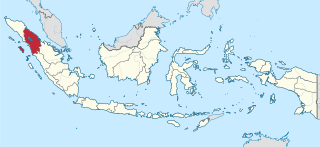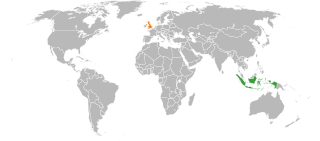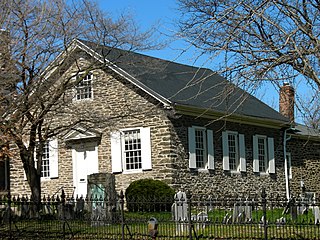The Third Great Awakening refers to a historical period proposed by William G. McLoughlin that was marked by religious activism in American history and spans the late 1850s to the early 20th century. It influenced pietistic Protestant denominations and had a strong element of social activism. It gathered strength from the postmillennial belief that the Second Coming of Christ would occur after mankind had reformed the entire Earth. It was affiliated with the Social Gospel movement, which applied Christianity to social issues and gained its force from the awakening, as did the worldwide missionary movement. New groupings emerged, such as the Holiness movement and Nazarene and Pentecostal movements, and also Jehovah's Witnesses, Spiritualism, Theosophy, Thelema, and Christian Science. The era saw the adoption of a number of moral causes, such as the abolition of slavery and prohibition.

North Sumatra is a province of Indonesia located on the northern part of the island of Sumatra. Its capital and largest city is Medan. It is bordered by Aceh on the northwest and Riau and West Sumatra in the southeast, with two different coastlines located on the Indian Ocean and the Strait of Malacca, and a maritime border with Malaysia to the east. The province also shares a very narrow maritime border with Thailand to the northeast. North Sumatra is Indonesia's fourth most populous province after West Java, East Java and Central Java, and the third-largest province on the island of Sumatra after the neighbouring Riau and South Sumatra. It covers an area of 72,981 km2. According to the 2020 census, the province's population in that year was 14,799,361. The mid-2022 official estimate was 15,115,206. North Sumatra is a multi-ethnic province. The Malay people are regarded as the natives of the east coast of the province, while the west coast of the province is mainly inhabited by the Batak. The central highlands region around Lake Toba is predominantly inhabited by other Batak groups. The Nias people are natives to Nias Island and its surrounding islets. With the opening of tobacco plantations in East Sumatra during the colonial era, the colonial government employed many contract labourers for plantations, mainly Chinese, Javanese and Indian migrants. The majority did not return after their contract ended and decided to stay in the province. The recent rapid urbanisation also attracted neighbouring people from Aceh, Riau and West Sumatra.
A Christian mission is an organized effort for the propagation of the Christian faith. Missions involve sending individuals and groups across boundaries, most commonly geographical boundaries, to carry on evangelism or other activities, such as educational or hospital work. Sometimes individuals are sent and are called missionaries, and historically may have been based in mission stations. When groups are sent, they are often called mission teams and they do mission trips. There are a few different kinds of mission trips: short-term, long-term, relational and those that simply help people in need. Some people choose to dedicate their whole lives to mission. Missionaries preach the Christian faith, and provide humanitarian aid. Christian doctrines permit the provision of aid without requiring religious conversion. However, Christian missionaries are implicated in the genocide of indigenous peoples. Around 100,000 native people in California, U.S., or 1/3 of the native population, are said to have died due to missions.

Batak is a collective term used to identify a number of closely related Austronesian ethnic groups predominantly found in North Sumatra, Indonesia, who speak Batak languages. The term is used to include the Karo, Pakpak, Simalungun, Toba, Angkola, and Mandailing ethnic groups. Which are related groups with distinct languages and traditional customs (adat).

Ludwig Ingwer Nommensen was a German Lutheran missionary to Batak lands, North Sumatra who also translated the New Testament into the native Batak language and the first Ephorus (bishop) of Batak Christian Protestant Church. Stephen Neill, a historian of missions, considered Nommensen one of the greatest missionaries of all time. He is commemorated as a missionary on 7 November in the Calendar of Saints of the Lutheran Church with John Christian Frederick Heyer and Bartholomäus Ziegenbalg.

The Huria Kristen Batak Protestan is a Lutheran church among the Batak people, generally the Toba Batak in Indonesia. It uses the Dutch Reformed style of worship due to the Dutch colonial heritage at the time it was founded. With a baptized membership of 4,500,000, it is one of the largest Protestant churches in Indonesia and Southeast Asia. Its present leader is Ephorus (bishop) Robinson Butarbutar.
The Rhenish Missionary Society was one of the largest Protestant missionary societies in Germany. Formed from smaller missions founded as far back as 1799, the Society was amalgamated on 23 September 1828, and its first missionaries were ordained and sent off to South Africa by the end of the year.
David William Bebbington is a British historian who is a professor of history at the University of Stirling in Scotland and a distinguished visiting professor of history at Baylor University. He is a Fellow of the Royal Society of Edinburgh and the Royal Historical Society.

Christianity is Indonesia's second-largest religion, after Islam. Indonesia also has the second-largest Christian population in Southeast Asia after the Philippines, the largest Protestant population in Southeast Asia, and the fourth-largest Christian population in Asia after the Philippines, China and India. Indonesia also has the second-largest Christian population in the Muslim world, after Nigeria, followed by Egypt. Indonesia's 29,1 million Christians constituted 10,49% of the country's population in 2022, with 7,43% Protestant (20.6 million) and 3,06% Catholic (8.5 million). Some provinces in Indonesia are majority Christian. In Indonesia, the word Kristen refers to Protestantism, while Catholicism is referred to as Katolik. In recent times, the rate of growth and spread of Christianity has increased, especially among the Chinese minority.
Characteristic of Christianity in the 19th century were evangelical revivals in some largely Protestant countries and later the effects of modern biblical scholarship on the churches. Liberal or modernist theology was one consequence of this. In Europe, the Roman Catholic Church strongly opposed liberalism and culture wars launched in Germany, Italy, Belgium and France. It strongly emphasized personal piety. In Europe there was a general move away from religious observance and belief in Christian teachings and a move towards secularism. In Protestantism, pietistic revivals were common.

Indonesia and the United Kingdom or Anglo-Indonesian relations established diplomatic relations in 1949 and have maintained strong relations since then. Indonesia has an embassy in London while the United Kingdom has an embassy in Jakarta. The United Kingdom considers Indonesia an increasingly important partner globally and is committed to efforts to take bilateral relations to new heights. Both nations are members of G-20 major economies.

Toba Batak people are the largest sub-group of the Batak people of North Sumatra, Indonesia. The common phrase of ‘Batak’ usually refers to the Batak Toba people. This mistake is caused by the Toba people being the largest sub-group of the Batak ethnic and their differing social habit has been to self-identify as merely Batak instead of ‘Toba’ or ‘Batak Toba’, contrary to the habit of the Karo, Mandailing, Simalungun, Pakpak communities who commonly self-identify with their respective sub-groups.

In the United States, evangelicalism is a movement among Protestant Christians who believe in the necessity of being born again, emphasize the importance of evangelism, and affirm traditional Protestant teachings on the authority as well as the historicity of the Bible. Comprising nearly a quarter of the U.S. population, evangelicals are a diverse group drawn from a variety of denominational backgrounds, including Baptist, Mennonite, Methodist, Pentecostal, Plymouth Brethren, Quaker, Reformed and nondenominational churches.

The evangelical revival in Scotland was a series of religious movements in Scotland from the eighteenth century, with periodic revivals into the twentieth century. It began in the later 1730s as congregations experienced intense "awakenings" of enthusiasm, renewed commitment and rapid expansion. This was first seen at Easter Ross in the Highlands in 1739 and most famously in the Cambuslang Wark near Glasgow in 1742. Most of the new converts were relatively young and from the lower groups in society. Unlike awakenings elsewhere, the early revival in Scotland did not give rise to a major religious movement, but mainly benefited the secession churches, who had broken away from the Church of Scotland. In the late eighteenth century and early nineteenth century the revival entered a second wave, known in the US as the Second Great Awakening. In Scotland this was reflected in events like the Kilsyth Revival in 1839. The early revival mainly spread in the Central Belt, but it became active in the Highlands and Islands, peaking towards the middle of the nineteenth century. Scotland gained many of the organisations associated with the revival in England, including Sunday Schools, mission schools, ragged schools, Bible societies and improvement classes.

Scottish Protestant missions are organised programmes of outreach and conversion undertaken by Protestant denominations within Scotland, or by Scottish people. Long after the triumph of the Church of Scotland in the Lowlands, Highlanders and Islanders clung to a form of Christianity infused with animistic folk beliefs and practices. From 1708 the Scottish Society for the Promotion of Christian Knowledge (SSPCK) began working in the area. In 1797 James Haldane founded the non-denominational Society for the Propagation of the Gospel at Home. Dozens of lay preachers, divinity students and English preachers were sent to the region. In the early nineteenth century a variety of organisations were formed to support evangelism to the region.
The Methodist Church in Indonesia or GMI is a body within the Methodist tradition in Indonesia. GMI is jointly presided by two bishops, each representing the component annual conferences within the church.

In missions history, a Bible woman was a local woman who supported foreign female missionaries in their Christian evangelistic and social work.

Margaret Stephen Kennedy was one of the first zenana missionaries in India in the mid nineteenth century. She is most known for her ability to connect with people along all classes and races, her work for the London Missionary Society orphanage in Benares, contributing aid to a leper sanctuary in Almora, and providing an English and Biblical education to the Raja of Coorg’s daughter, Victoria Gouramma.

The Bible Society of Singapore, Malaysia and Brunei was a nondenominational Christian organisation committed to translating and distributing the Bible in Singapore, Malaysia, and Brunei. It was the successor organisation to the Bible Society of Malaya, a branch of the National Bible Society of Scotland (NBSS). The Bible Society of Malaya prior to 1948 was a branch of the British and Foreign Bible Society (BFBS).
Christian manliness is a concept and movement that arose in Victorian Protestant England, characterised by the importance of the male body and physical health, family and romantic love, the notions of morality, theology and the love for nature and, the idea of healthy patriotism, with Jesus Christ as leader and example of truest manhood. The concept was first brought up in novels by the British Victorian writers Charles Kingsley and Thomas Hughes. Schoolmaster of the Rugby School, Thomas Arnold, was responsible for reforming the British public schooling system according to notions of biblical manhood. The Christian manliness movement can still be observed in the Anglosphere today, and although it shares a great deal with the notions and ideals originating from the Victorian era, it is distinct and shaped by the constraints and conditions of the modern post-industrial era. The American evangelical community places emphasis upon Christian manliness.


















